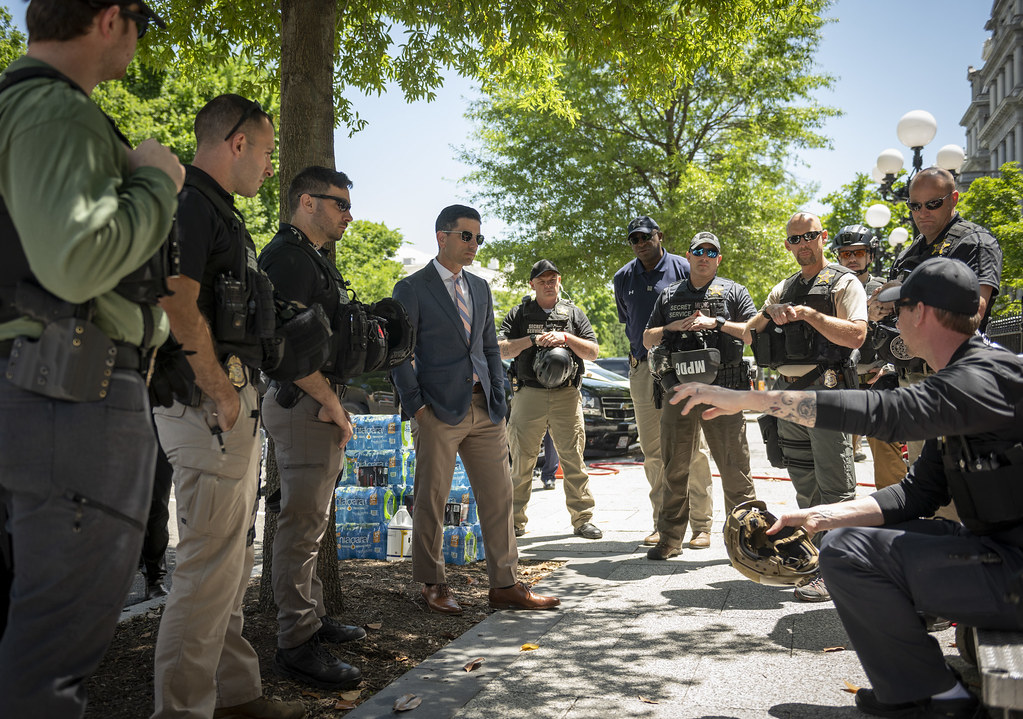Department of Homeland Security Law Enforcement Agencies Require Expanded Oversight
The potential for expanded interior Homeland Security law enforcement activity raises questions about whether components of the department being called upon are subject to appropriate training, preparation and accountability.

Published by The Lawfare Institute
in Cooperation With

Hundreds of Department of Homeland Security officers have been called up to serve along with other federal law enforcement officers and the National Guard to provide security within the District of Columbia. The presence of the U.S. Secret Service and Federal Protective Service—both Homeland Security agencies—is routine at the White House and other federal facilities. But less common is the use of U.S. Customs and Border Protection (CBP), Immigration and Customs Enforcement (ICE), and Transportation Security Administration (TSA) officers alongside local and federal law enforcement to quell domestic unrest. Exactly how Homeland Security activities will expand on a day-to-day basis to directly engage in law enforcement activity in the District of Columbia or elsewhere is, as of yet, unclear. But the potential for expanded interior Homeland Security law enforcement activity raises questions about whether components of the department being called upon in the tense current environment are subject to appropriate training, preparation and accountability.
So far this week, CBP deployed an unarmed Predator drone over the skies of Minneapolis, Minnesota, presumably to provide air surveillance support to local law enforcement as protests spread across the region. And a contract security officer of the Federal Protective Service was killed in the line of duty while “keeping watch over” a protest in Oakland, California. As protests in response to the murder of George Floyd, and concurrent violent disruptions, spread around the country, Acting CBP Commissioner Mark Morgan said in a tweet that “[t]hese ‘protests’ have devolved into chaos & acts of domestic terrorism by groups of radicals & agitators. @CBP is answering the call and will work to keep DC safe.” As a result, Homeland Security officers charged with border and related security functions are now actively working inside the country on a mission distinct from their usual remit: interior physical security and law enforcement. Within the District of Columbia—where federal authority is different than in the 50 states—that activity so far appears to involve, at least, protecting federal sites such as monuments. The deployment of these law enforcement officers beyond the scope of their day-to-day responsibilities, in the most tense civic environment in decades, has the potential to go sideways quickly. That the president—who has called for “dominance” of the civilian population by law enforcement—has looked to Homeland Security previously to implement his political objectives without sufficient oversight only heightens the concern that department officers will be put in a situation for which they have inadequate preparation and that could spiral quickly out of control. The escalating situation heightens the imperative for congressional oversight.
When Congress created the Department of Homeland Security in 2002, it did so to better protect the country against terrorism. In that era, that meant primarily international, Islamist-directed or inspired terrorism, as defined and discussed in the 9/11 Commission Report. The department brought together border security, immigration enforcement, transportation security, immigration adjudication, protection against chemical and biological weapons, and many other domestic security functions under one organizational umbrella and cabinet official. Over time, the department also bolstered its cybersecurity capabilities and responsibilities, and it shares information and intelligence regarding domestic terrorism, an increasing menace. The department’s role has evolved into providing an important coordination function among other components of the federal government, such as the intelligence community and other federal law enforcement agencies, as well as state, local and tribal officials. What Congress didn’t do, however, was intentionally create a national police force.
Yet today, the acting secretary of homeland security sits atop the largest federal law enforcement organization in the country, with well over 60,000 law enforcement officers under his authority. The department’s law enforcement manpower dwarfs that of the FBI, the Drug Enforcement Administration, and the Bureau of Alcohol, Tobacco, Firearms and Explosives, combined. The head of the largest federal law enforcement force in the United States is not FBI Director Christopher Wray or even Attorney General William Barr. It’s Chad Wolf.
Earlier this month, I released a report at the Center for a New American Security highlighting the need for greater oversight and accountability of the Department of Homeland Security’s border security, immigration enforcement and law enforcement functions. Despite its size and scope of serious responsibilities, the department’s internal controls have simply not matured to the extent they need to. As former Homeland Security Inspector General John Roth testified before Congress last year, the department has “a dysfunctional work environment” and “weak internal controls.” The report recommends that Congress beef up its oversight, with a particular focus on requiring development of and transparency about updated operating guidelines for law enforcement activities. The department is in need of better institutional coordination of its oversight and accountability functions.
The need for greater oversight and accountability arises from the persistent low morale and difficulty stemming public corruption from within the department’s ranks, compounded by the department’s weakened leadership that is increasingly susceptible to politicization. President Trump has forced the resignation of or removed or fired Senate-confirmed leaders across the department throughout his term in office. Among those fired include the former general counsel of the department, who had been confirmed by the Senate, and was replaced at first by a career official, followed by a political appointee. More broadly, the lack of Senate-confirmed leadership of the department—which as of this winter included more than 18 key leadership positions—contributes to a lack of accountability coupled with a seeming enthusiasm for engaging in political dialogue. Acting senior officials mimic the president’s political rhetoric, eroding public confidence in the apolitical administration of law enforcement functions. Department personnel were exposed as having taken part in a social media group rampant with sexism and racism. The department’s inspector general’s office increasingly lies low.
This week’s deployment of Homeland Security officers to support other federal law enforcement agencies is likely justifiable under emergency provisions of Title 34, and the federal government has wide authority in D.C. versus in the states. In addition, law enforcement agencies often have agreements to provide assistance when needed. But if the department’s activities diverge from support and assistance to active policing in American cities, the department will need to clearly articulate its authority. Immediately relevant, however, is whether the deployed officers are adequately trained and prepared for the current tense environment. Repurposing law enforcement officers to work in a tense civic moment is not as easy as it might sound. As we are seeing in the hourly videos pouring in from across the country, some law enforcement personnel are prepared for the unique environment of civilian protests or violence; others are not, and the consequences can range from the embarrassing to the dangerous.
The Center for a New American Security oversight and accountability report on the Department of Homeland Security (DHS) concludes that:
DHS is at a perilous juncture: It performs critical functions to protect the country from threats and hazards and houses the largest federal law enforcement force in the country, but as an institution it has not matured sufficiently to ensure adequate oversight and accountability over those activities. This report, after laying out specific challenges, makes six key recommendations to improve oversight and accountability and calls on Congress to build them into legislation so that they become institutionalized and not degraded based on fluctuations in political leadership. The goal in issuing this report is to underscore the urgency in greater congressional interest in DHS’s future, and propose practical recommendations that will place DHS on sound footing to support its mission consistent with the rule of law and American values.
As the president mobilizes the department to increase its law enforcement presence throughout the country in a time of civil unrest, the need for oversight attention could not be more timely. As the report recommends, Congress can legislate requirements for modernized guidelines, transparency about law enforcement activities, and better organizational structure to ensure coordinated oversight and accountability across the department. Officers and agents of this important department deserve competent leadership, as well as adequate preparation and training for the duties they will be called on to serve. And the public deserves the comfort of knowing that the president is not able to use law enforcement functions in the service of political objectives.



.jpg?sfvrsn=676ddf0d_7)

